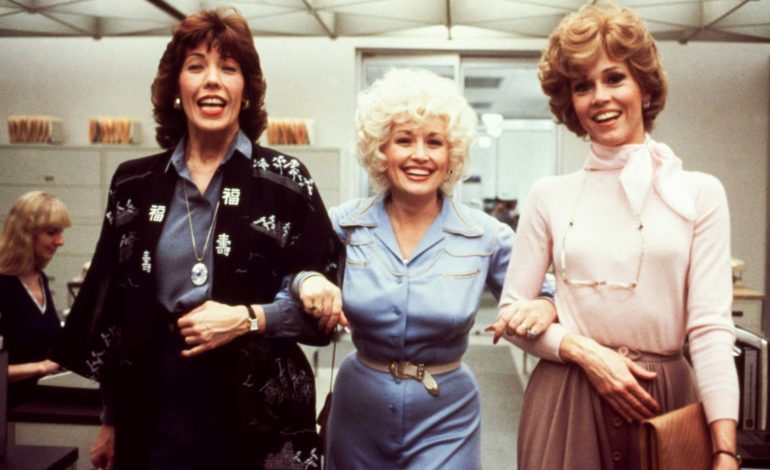

Long before they teamed up to sell geriatric sex toys in Netflix’s Grace and Frankie, Jane Fonda and Lily Tomlin were empowering an entirely different generation of women in the 1980 comedy classic, 9 to 5. Or, more accurately, they were empowering a younger version of the same generation.
In the ensuing four decades since 9 to 5’s initial release, the workplace revenge fantasy has remained a cultural touchstone, spawning a TV series and musical of the same. This longevity is due in part to how the film speaks to a timeless and universal experience. After all, who among us hasn’t dreamed at one point or another of hogtieing our boss, poisoning his coffee while surrounded by cartoon songbirds, or simply being Lily Tomlin? We’ve all been there.
But of course, the film is more than just a story about the pitfalls of working for a terrible boss, or the benefits of being a brilliant comedienne. It is a poignant if deeply silly look at the treatment of women in the workplace. And perhaps what really makes the film stand the test of time is just how little has changed in the last forty years. Despite its aggressively 80s aesthetic – Jane Fonda’s glasses alone are the visual equivalent of the synthesizer from Dancing in the Dark – the actual story could be just as easily be transposed to the #MeToo era by throwing in a few smartphones, and maybe a reference to The Irishman to spare millennials the trouble of googling who Jimmy Hoffa was.


Franklin Hart Jr, played with perfectly mustachioed smarm by Dabney Coleman, is the sexist, egotistical, lying, hypocrite of a boss at Consolidated Companies, a company that…consolidates things? Perhaps other companies? In true 80s fashion, it’s never fully explained what the company actually does, which is fitting, as the man running the office doesn’t actually do much to work. Instead, he spends his days terrorizing his team of female subordinates. Hart lashes out at Judy (Fonda) for a minor technical mishap on her first day, steals ideas from Violet (Tomlin), then refuses her a promotion for lacking the all-important qualification of being a man, and overtly sexually harasses Doralee, played by Dolly Parton in her film debut. When his advances are politely rejected, he responds by spreading lascivious rumors about her around the office. Or, as it was called in the 80s, professionalism.
As underappreciated employees have done for generations, the trio bonds over their hatred of the common enemy – not to mention a deceptively potent joint. The result is a series of over-the-top reenactments about all the different ways they have fantasized about bumping off the boss. Judy becomes Annie Oakley, chasing Hart into the bathroom with a rifle. Doralee treats him to the same brand of unwanted advances that he routinely doles out, forcing him to spin around so she can properly critique the tightness of his pants. And to cap it all off, Violet transforms into a full-blown Disney Princess, but with actual character development and agency. These sequences balance dark and light comedy perfectly, delivering perfectly relatable visions of cruelty tempered with a wacky absurdity that keeps them from feeling too malicious.
If the film suffers on contemporary viewings, it is largely because it delivers this high point of viciousness so early in its runtime, then backs away from it immediately. When Violet nearly poisons Hart in real life, sending him to the hospital with little more than a bump on the head, she’s horrified at what she has done. Almost as if to cleanse the palate and make clear that these women are not bad people, their guilt gives way to an extended screwball corpse mix-up that turns our strong, smart, capable women into a bumbling Three Stooges act. Some of Violet’s concern for Hart’s well-being is self-motivated, even asking, “I’ve killed the boss, you think they’re not gonna fire me for a thing like that?” Still, the whole thing feels like an unnecessary reset designed to make us remember the women are good and Hart is the undisputed villain, especially when he uses the almost-poisoning as leverage to get into Doralee’s pants.


By the time the film turns around and the trio start acting out their fantasies again, kidnapping Hart and chaining him up to a Chekov’s Garage Door Opener, the plot begins to feel almost like a genteel farce. Murder gives way to blackmail, followed by a montage of Hart being bored-if mostly comfortable-while the women finally take control of the office. When Hart is finally breaks free and returns to work with a gun, even his own attempt to ratchet up the drama is quickly and casually diffused by a surprise visit from the Chairman of the Board (Sterling Hayden). Amusingly, he gives Hart a “promotion” to Brazil and hands control of the office to Violet, all without acknowledging that she was the one who saved it.
Violet’s lack of recognition is perhaps a fitting end to a story that hasn’t changed much in the last forty years. In one of its most prescient moments, the Chairman reviews and praises all of the changes the women have made to the office while Hart was away, save for one: equal pay. Because even if this story has a happy ending, that doesn’t mean they all will.
Verdict: 4 out of 5 Stars.
Despite its flaws, 9 to 5 is still a powerful piece of feminist cinema. Its outstanding leading cast, witty screenplay, and sadly realistic depiction of corporate sexism keep the film fresh, fun, and relevant in the modern era. It will make you laugh, think, and hum Parton’s earworm of a theme song for an embarrassingly long time.
